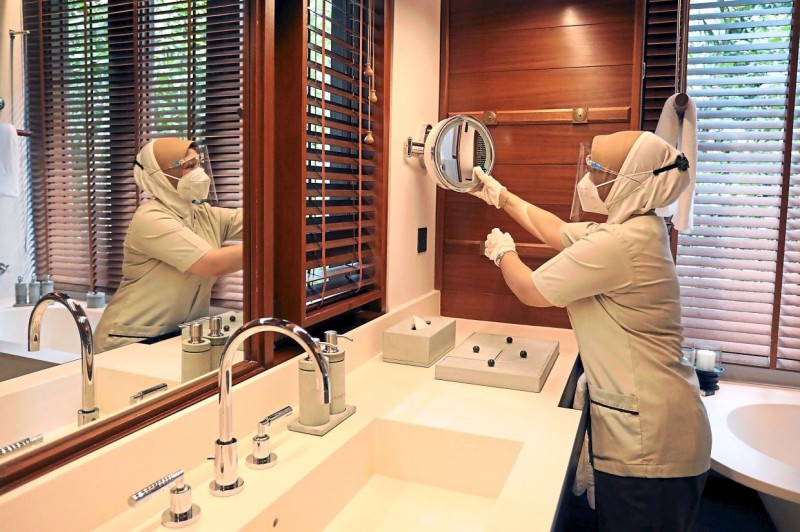
Image credit: The Star
POPULAR domestic destinations saw pent-up demand with many travelling out of the Klang Valley, typically choosing resorts and islands for their long-awaited getaway.
But average occupancy for the country was only around 40%, with hotel occupancy peaking over the long weekends at popular holiday and nature destinations, while for others, it was moderate.
“With only the domestic market to work on, business is still limited at a lower spending power, while demand is still fluctuating between weekdays and weekends,’’ said Malaysian Hotels Association (MAH) chief executive officer Yap Lip Seng.
Sunway Hotels International sees its hotels in Sunway City Kuala Lumpur running at full occupancy every weekend since the lifting of interstate travel.
Demand at Sunway Pyramid Hotel and Sunway Clio Hotel has been overwhelming since the relaxation of standard operating procedures (SOPs).
“We are also privileged to be located in Sunway City Kuala Lumpur, which is a world-class destination that seamlessly integrates our hotels to the theme park, shopping mall, medical centre and more.
“Sunway City Kuala Lumpur is also one of the region’s leading and premier destinations for meetings and events; since the relaxation of SOPs, we have been receiving many enquiries and confirmation for small to medium-sized meetings and events from KL-based companies,’’ said Sunway Hotels International.
Sunway is also in discussions with a few organisers on events next year which will involve international delegates.
Sunway Resort is undergoing a US$60mil (RM251.7mil) transformation, scheduled to reopen in phases in the first quarter of 2022.
“The hospitality industry will need to step into the future as we embrace a new generation of leisure and business guests who are very tech-savvy, and Sunway Resort is equipped for this,’’ said Sunway Hotels International.
Within this domestic tourism is a group of travellers who are willing to spend more; they used to travel overseas but are now confined to within the country.
Currently driving business to the high-end hotels and resorts, these tourists may shift back to their preferred international destinations once international borders reopen.
Hotels on the lower end are still subjected to heavy costs, especially now that operations are back to normal; there are more bills to pay along with higher manpower costs.
From a MAH survey, the hotel industry in Malaysia has a market mix of 55% domestic and 45% international; without international arrivals, the industry would not be expecting full recovery.
“The domestic market will only be dominant for the next one year with much lower spending power,’’ said Yap.
Based on a Tourism Malaysia report 2019, the average spending of a domestic tourist is about RM400, and RM3,000 for an international tourist.
“The industry could be looking at receiving international guests again in 2022, but a full recovery will take another one to two years, into 2023-2024,’’ said Yap.
“But we cannot get local hotel workers and even foreign workers; so at 40% occupancy, we cannot cope with service demand,’’ said Corus Hotel.
Hotels are doing their best to hang on; basically, they are in a depressed situation with reduced manpower and strained resources; they are not able to take in maximum occupancy due to shortage of staff.
Many staff who were retrenched, on no-pay or half-pay, are not returning to their jobs.
Costs have also gone up on regular sanitising and compliance with SOPs.
Proposals from the Malaysian Association of Hotel Owners (MAHO) include:
> Continuation of the wage subsidy programme until the end of 2022.
> Extension of a lower electricity tariff or the giving of discounts of at least 25% on the energy bill.
> Revision of the Indah Water Konsortium fixed monthly charge which is “unreasonably charged based on property evaluation.’’
> Creation of a special fund for the recovery of tourism.
“We suggest the government develops a programme to have a local human capital pool for the hospital/service industry; currently, there is strict control on employment of foreign workers for the service industry.
“But locals are not keen to take up the jobs which they claim are 3D (dirty, dangerous and difficult) jobs,’’ said MAHO executive director Shaharuddin Mohamed Saaid.
Some hotels in the Malaysian Budget Hotel Association (MyBHA), which were closed during the movement control order, are not operating due to staffing and financial problems.
“We seek some grants for operators, continuation of the wage subsidy, waiver of the sales and service tax for 2022, and better discounts on utilities,’’ said MyBHA president Hajjah Emmy Suraya Hussein.
To rebuild confidence and assurance in the industry, the government should:
> make a clear public statement on the full reopening of the tourism industry, including international borders, and that there should be little-to-no worry of another travel ban.
> recreate the image of the hospitality industry and encourage careers in hospitality.
> relook into capacity-related SOPs (for restaurants, meeting rooms and ballrooms) while reviewing the practicality of allowing businesses to maximise their usage, said Yap of MAH.
> be more active and creative in the meetings, incentives, conferences and exhibitions (MICE) market by incentivising players to host their events in the country.
> be consistent in enforcing restrictions and SOPs as constant change puts us and our clients in a difficult position when planning a holiday or event, said Sunway Hotels International.
With 40% occupancy in the domestic market, the hotel sector cannot afford to suffer another hit, either from further flooding or a rise in Omicron infections especially on non-adherence to SOPs.
Source: https://www.thestar.com.my/business/business-news/2021/12/27/hotels-see-pent-up-demand-in-domestic-sector

